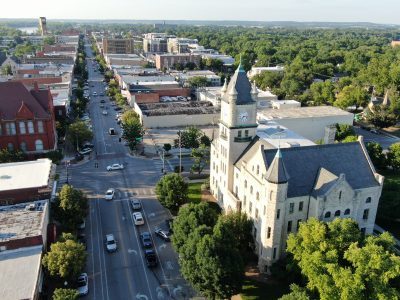
New sales tax numbers show Lawrence took one of the hardest hits in the state during shutdown

photo by: Jackson Barton/Journal-World File Photo
The Douglas County Courthouse and downtown Lawrence are pictured in an aerial photo Saturday, July 13, 2019.
The hit to retail businesses from the pandemic is showing up in new sales tax numbers, and they indicate Lawrence has suffered one of the starkest slowdowns of any major city in the state.
Lawrence’s sales tax collections dropped 13.2% in the June sales tax report issued by the state today. The June report, due to normal delays in sales tax reporting, mainly represents sales that were made in April, which was the first full month in which businesses faced pandemic-related restrictions on their operations. In dollar terms, Lawrence’s loss was about $273,000, compared with the same month a year ago.
Among major retail centers in the state, only Overland Park, which has the largest collection of shopping malls in the area, had a steeper drop in sales tax numbers than Lawrence. Here’s a look at how sales tax collections fared for the major retail centers compared with the same month a year ago.
• Overland Park: down 17.8%
• Lawrence: down 13.2%
• Manhattan: down 12.5%
• Kansas City: down 12.5%
• Topeka: down 6.2%
• Salina: down 4.6%
• Shawnee: down 4.2%
• Olathe: up 0.4%
• Sedgwick County: up 1.6%
• Lenexa: up 5.3%
This month’s report is basically a reversal from last month’s report. The May report, which reported sales made mainly in March, wasn’t great for Lawrence by any means. Sales tax collections were down by about 7%, but that was the second-best showing of any of the major retail centers in the state. Some interpreted that as a ray of hope.
Now that light at the end of the tunnel doesn’t look so much like hope. What’s significant about this month’s report is that it marks the first full month that Lawrence went without KU students. They were here most of March. The pandemic shutdown didn’t begin until spring break, when the Lawrence economy slows down anyway. But then, of course, they never came back.
That is what should make Lawrence different from a lot of other communities across the country. We not only have businesses operating at reduced capacities, we actually have lost a significant amount of population. Most communities haven’t lost population because of the pandemic. We know all KU students abandoned their dorms, and it is tough to say how many abandoned their apartments. I think it is reasonable to believe Lawrence’s population has declined by at least 10,000 people. Because of that, there is a case to be made that college communities face an extra layer of pandemic pain. Whether it results in an extra layer of federal relief funds is unclear.
Next month’s report, which will show results for May, will be worth watching. May should have been full of students in Lawrence, but was not, plus it will have the added pain of lost visitor spending that normally happens with KU’s commencement ceremony. That could be an ugly report.
Or maybe it will be a surprise. Thus far the numbers have been erratic statewide. The June report showed that, overall, the decline in local sales tax collections was just 2.5%. That number is somewhat artificially deflated because it doesn’t factor out communities that have raised their sales tax rates over the course of the last year. Regardless, it is a lot lower than the 13% drop Lawrence experienced.
Even in Douglas County the wide swings were on display. Baldwin City, a college town with Baker University as its largest employer, had a 17% increase in sales tax collections for the month. Eudora, a more typical small town, was down 6.1%.
A good reminder, though, that this is just one month’s worth of data. Big variations aren’t that uncommon. The good news for Lawrence is that the 13% decline hasn’t sunk the community’s economy. When you look at the year-to-date totals, Lawrence’s total sales tax collections are down a more reasonable 2.6% compared with the same period a year ago. In dollar terms, Lawrence has collected $330,000 less than it did a year ago.
The better news for Lawrence, at least for City Hall’s coffers, is that the amount of use tax that the city is collecting through online purchases continues to grow some. Year to date, Lawrence has collected $1.68 million in use taxes compared with $1.61 million during the same period a year ago. That’s clearly not enough to make up for the $330,000 in lost sales taxes, but thus far the pandemic hasn’t put those online sales tax numbers into negative territory. In fact, the June report shows they grew significantly during the shutdown. They were up 21%, or about $52,000, compared with the same month a year ago.
If local businesses aren’t selling online, that is not great news for them, but such numbers may help blunt a pending budget crisis at City Hall.







